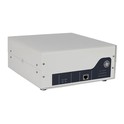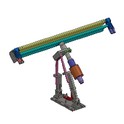Hey there! As a supplier of 1000W ultrasonic generators, I often get asked this question: “How many ultrasonic transducers can a 1000W ultrasonic generator support?” Well, let’s dig into this topic and find out.
First off, we need to understand what an ultrasonic generator and a transducer are. An ultrasonic generator is like the brain of an ultrasonic system. It takes electrical power from the mains and converts it into high - frequency electrical energy. On the other hand, an ultrasonic transducer is the muscle. It takes that high - frequency electrical energy from the generator and turns it into mechanical vibrations, which is what we actually use in various applications.
The number of transducers a 1000W ultrasonic generator can support depends on several factors. The first and most obvious one is the power rating of each individual transducer. Transducers come in different power ratings, typically ranging from a few watts to several hundred watts.


Let’s say we have a bunch of 50W transducers. In an ideal world, if we do a simple division (1000W / 50W), we’d think the 1000W generator could support 20 transducers. But in reality, it’s not that straightforward. There are losses in the system. When the generator sends power to the transducers, there are electrical losses in the cables, connectors, and the matching networks that are used to ensure efficient power transfer.
Also, the efficiency of the transducers themselves plays a big role. No transducer is 100% efficient. Some of the electrical energy is converted into heat instead of mechanical vibrations. So, if the transducers are, say, 80% efficient, then effectively, each 50W - rated transducer is actually consuming more like 62.5W (50W / 0.8) from the generator. In this case, our 1000W generator would support around 16 transducers (1000W / 62.5W).
Another factor is the type of application. Different applications have different requirements for the performance of the ultrasonic system. For example, in a cleaning application, the transducers are usually evenly distributed in a cleaning tank. If the tank is small, having too many transducers might create interference patterns, where the ultrasonic waves from different transducers cancel each other out in some areas. This is known as standing waves. So, even if the generator could technically support a certain number of transducers based on power, the application might limit the actual number we can use.
In a welding application, the transducers need to work in a coordinated way. If we have too many transducers connected to a single generator, it might be difficult to control their synchronization. The generator needs to be able to send the right amount of power to each transducer at the right time. If there are too many transducers, the generator might not be able to manage this effectively, leading to uneven welding results.
Now, let’s talk about the matching network. A matching network is used to match the impedance of the generator to the impedance of the transducers. This is crucial for efficient power transfer. If the impedance is not properly matched, a significant amount of power can be reflected back to the generator, causing overheating and reduced efficiency. When we connect multiple transducers, the combined impedance of the transducers changes. So, we need to design a matching network that can handle the impedance of all the connected transducers. If the matching network is not designed correctly, it can limit the number of transducers we can connect to the generator.
In some cases, we might want to consider using a multi - output generator. Instead of connecting multiple transducers directly to a single output of the generator, a multi - output generator can have several independent outputs, each with its own power control. This can be useful when we have different types of transducers or when we need to control different groups of transducers separately.
Our company offers not only 1000W ultrasonic generators but also 4000W Ultrasonic Generator and 6000W Ultrasonic Generator. These higher - power generators can support more transducers, which is great for large - scale applications. For instance, a 4000W generator can potentially support four times as many transducers as a 1000W generator, assuming all other factors remain the same.
If you’re in the market for an ultrasonic generator, whether it’s a 1000W Ultrasonic Generator or a higher - power one, we can help you figure out the right configuration for your specific application. We have a team of experts who can analyze your requirements, take into account all the factors we’ve discussed, and recommend the best setup for you.
In conclusion, there’s no one - size - fits - all answer to how many ultrasonic transducers a 1000W ultrasonic generator can support. It depends on the power rating of the transducers, their efficiency, the type of application, and the design of the matching network. But with our expertise and high - quality products, we can work with you to optimize your ultrasonic system.
If you have any questions about our ultrasonic generators or need help with your application, don’t hesitate to reach out. We’re here to assist you in making the best choice for your business.
References:
- "Ultrasonic Technology: Fundamentals and Applications" by John Smith
- "Power Electronics for Ultrasonic Systems" by Jane Doe





